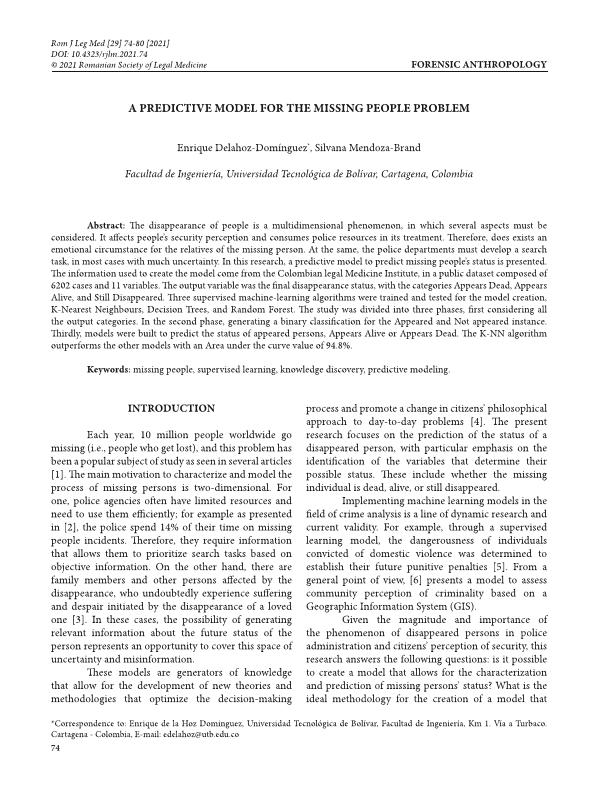Mostrar el registro sencillo del ítem
A predictive model for the missing people problem
| dc.contributor.author | De la Hoz Domínguez, Enrique José | |
| dc.contributor.author | Mendoza-Brand, Silvana | |
| dc.coverage.spatial | Colombia | |
| dc.date.accessioned | 2022-01-27T14:51:33Z | |
| dc.date.available | 2022-01-27T14:51:33Z | |
| dc.date.issued | 2021-03-01 | |
| dc.date.submitted | 2022-01-26 | |
| dc.identifier.citation | E. D. Domínguez, S. M. Brand Rom J Leg Med29(1)74-80(2021) DOI:10.4323/rjlm.2021.74 | spa |
| dc.identifier.uri | https://hdl.handle.net/20.500.12585/10413 | |
| dc.description.abstract | The disappearance of people is a multidimensional phenomenon, in which several aspects must be considered. It affects people’s security perception and consumes police resources in its treatment. Therefore, does exists an emotional circumstance for the relatives of the missing person. At the same, the police departments must develop a search task, in most cases with much uncertainty. In this research, a predictive model to predict missing people’s status is presented. The information used to create the model come from the Colombian legal Medicine Institute, in a public dataset composed of 6202 cases and 11 variables. The output variable was the final disappearance status, with the categories Appears Dead, Appears Alive, and Still Disappeared. Three supervised machine-learning algorithms were trained and tested for the model creation, K-Nearest Neighbours, Decision Trees, and Random Forest. The study was divided into three phases, first considering all the output categories. In the second phase, generating a binary classification for the Appeared and Not appeared instance. Thirdly, models were built to predict the status of appeared persons, Appears Alive or Appears Dead. The K-NN algorithm outperforms the other models with an Area under the curve value of 94.8%. | spa |
| dc.format.extent | 7 Páginas | |
| dc.format.mimetype | application/pdf | spa |
| dc.language.iso | eng | spa |
| dc.rights.uri | http://creativecommons.org/licenses/by-nc-nd/4.0/ | * |
| dc.source | Rom J Leg Med - vol. 29 n° 1 (2021) | spa |
| dc.title | A predictive model for the missing people problem | spa |
| dcterms.bibliographicCitation | Burch RA. Presumed Dead: Why Arizona Should Shorten the Required Time for Beloved Missing Persons to Be Declared Legally Dead. Ariz. Summit Law Rev. 2017; 10: 59. | spa |
| dcterms.bibliographicCitation | Yang Y, Hu X, Liu H, Jiawei Z, Li Z, Yu P.S. r-instance Learning for Missing People Tweets Identification. 2018 | spa |
| dcterms.bibliographicCitation | Parr H, Stevenson O, Woolnough P. Search/ing for missing people: Families living with ambiguous absence. Emot. Space Soc. 2016; 19: 66-75. | spa |
| dcterms.bibliographicCitation | Mannini A, Sabatini AM. Machine Learning Methods for Classifying Human Physical Activity from On-Body Accelerometers. Sensors. 2010; 10 (2). | spa |
| dcterms.bibliographicCitation | Berk RA, Sorenson SB, Barnes G. Forecasting Domestic Violence: A Machine Learning Approach to Help Inform Arraignment Decisions. J. Empir. Leg. Stud. 2016; 13(1): 94-115. | spa |
| dcterms.bibliographicCitation | Cutajar J, Formosa S, Calafato T. Community Perceptions of Criminality: The Case of the Maltese Walled City of Bormla. Soc. Sci. 2013; 2(2). | spa |
| dcterms.bibliographicCitation | Base de datos preliminar de personas reportadas como Desaparecidas Enero-Noviembre 2017 | Datos Abiertos Colombia». https://www.datos.gov.co/Estad-sticas-Nacionales/Base-de-datospreliminar- de-personas-reportadas-co/85g8-qemt (accedido oct. 07, 2020). | spa |
| dcterms.bibliographicCitation | Burrell J. How the machine ‘thinks’: Understanding opacity in machine learning algorithms. Big Data Soc. 2016; 3(1). | spa |
| dcterms.bibliographicCitation | Kataria A, Singh MD. A Review of Data Classification Using K-Nearest Neighbour Algorithm. 2013. | spa |
| dcterms.bibliographicCitation | Therneau T, Atkinson B, Ripley B. Recursive Partitioning and Regression Trees. 2019. | spa |
| dcterms.bibliographicCitation | Breiman L. Random Forests. Mach. Learn. 2001; 45(1): 5-32. | spa |
| dcterms.bibliographicCitation | Franco RMF, Giraldo GCV. Identifying missing people in the National Database of Genetic Profiles for Application in Judicial Investigation —CODIS—: Two case reports. Case Rep. 2015; 1(2). | spa |
| dcterms.bibliographicCitation | Pan L, Liu G, Lin F, Zhong S, Xia H, Sun X, Liang H. Machine learning applications for prediction of relapse in childhood acute lymphoblastic leukemia. Sci. Rep. 2017; 7(1). | spa |
| datacite.rights | http://purl.org/coar/access_right/c_abf2 | spa |
| oaire.version | http://purl.org/coar/version/c_ab4af688f83e57aa | spa |
| dc.type.driver | info:eu-repo/semantics/article | spa |
| dc.type.hasversion | info:eu-repo/semantics/restrictedAccess | spa |
| dc.identifier.doi | 10.4323/rjlm.2021.74 | |
| dc.subject.keywords | Missing people | spa |
| dc.subject.keywords | Supervised learning | spa |
| dc.subject.keywords | Knowledge discovery | spa |
| dc.subject.keywords | Predictive modeling | spa |
| dc.rights.accessrights | info:eu-repo/semantics/openAccess | spa |
| dc.rights.cc | Attribution-NonCommercial-NoDerivatives 4.0 Internacional | * |
| dc.identifier.instname | Universidad Tecnológica de Bolívar | spa |
| dc.identifier.reponame | Repositorio Universidad Tecnológica de Bolívar | spa |
| dc.publisher.place | Cartagena de Indias | spa |
| dc.subject.armarc | LEMB | |
| dc.type.spa | http://purl.org/coar/resource_type/c_2df8fbb1 | spa |
| oaire.resourcetype | http://purl.org/coar/resource_type/c_6501 | spa |
Ficheros en el ítem
Este ítem aparece en la(s) siguiente(s) colección(ones)
-
Productos de investigación [1453]
Universidad Tecnológica de Bolívar - 2017 Institución de Educación Superior sujeta a inspección y vigilancia por el Ministerio de Educación Nacional. Resolución No 961 del 26 de octubre de 1970 a través de la cual la Gobernación de Bolívar otorga la Personería Jurídica a la Universidad Tecnológica de Bolívar.













